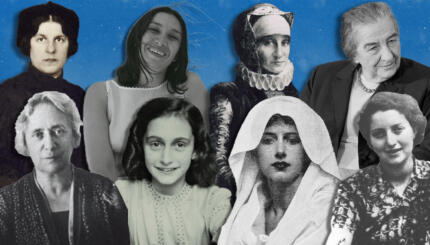Interestingly, sexual intimacy between women was not mentioned at all in Jewish texts until 1,500 years ago. When we turn to the first source of Jewish teaching, the Torah, the Five Books of Moses, redacted either as early as the tenth century or as late as the fifth century BCE, we find that the sections which outline prohibited sexual unions (Leviticus 18 and 20) do not include a single word about lesbianism. Leviticus 18:22, addressing the individual male, states clearly: “You shall not lie with a male as with a woman. It is an abhorrence” (to’evah). And Leviticus 20:13 adds: “And a man who lies with a male as with a woman, both of them have committed an abhorrence: They shall surely be put to death; their blood shall be upon them.”
READ: What You Need to Know About Judaism and LGBTQ Issues
The context of each verse is a lengthy statement detailing prohibited sexual unions; the operating rationale is the separation of Israel from the peoples around them, and their consecration to God. And it is here, right at the beginning of the story of homosexuality and Judaism, that we find a clue to the assumptions underlying Jewish teaching on lesbianism which emerged centuries later: women are included in the texts of Leviticus 18 and 20, of course, but with the exception of the case of bestiality (Lev. 18:23), women are the objects, not the subjects, of the different types of sexual union, and there is no mention at all of women in relation to one another.
The first fleeting allusion to sexual contact between women is made by the rabbinic sages in Sifra (Acharei Mot 9:8), a work of halakhic midrash (that is, rabbinic exegesis of legal biblical material) which comments on the book of Leviticus and was edited no earlier than the end of the fourth century CE (when the Jerusalem Talmud was completed). Here, referring to the “laws” of Egypt and Canaan which the Israelites are prohibited from following (Lev. 18:3), the text cites as an example that “a man would marry [nosei] a man, and a woman a woman”—a clear reference not only to same-sex intimate acts, but also to on‑going relationships between same‑sex partners.
With your help, My Jewish Learning can provide endless opportunities for learning, connection and discovery.
The next brief comments are found in the Babylonian Talmud—edited about 100 years later in two different tractates: Shabbat and Yevamot. Shabbat 65a/b refers to the father of Samuel (Samuel being the pre‑eminent authority among Babylonian Jewry in the middle of the third century) not permitting his daughters “to sleep together”. The text offers two explanations for his position: one view links it to a teaching of Rav Huna (a disciple of Samuel’s principal colleague and sparring partner Rav): “For R. Huna said: ‘Women that play around [hamesolelot] with one another are unfit [pesulot] for the priesthood [i.e. to marry a High Priest].’” The majority of the sages, however, reached a different conclusion: “No: it was in order that they should not become accustomed to an alien body [gufa nuchra’ah].”
Yevamot 76a makes it clear why the law does not follow Rav Huna. After quoting his teaching the text adds:
“And even according to Rav Eleazar, who stated that an unmarried man who cohabited with an unmarried woman with no matrimonial intention renders her therefore a prostitute [zona], this disqualification ensues only in the case of a man, but when [the case] is that of a woman [playing around with another woman] the action is regarded as mere obscenity.”
Rav Huna’s teaching is rejected because, unlike heterosexual cohabitation, sexual intimacy between women does not render the individual women concerned “unfit”; it is peritzuta, “obscenity”, not zenut, “unchastity” or “harlotry”. And if the women’s behavior does not render them “unfit”, they are not thereby debarred from marrying a High Priest (who must only marry a virgin—that is, a woman who is “fit”). Interestingly, the expression “play[ing] around”, hamesolelot, is a rabbinic euphemism for sexual behavior (sometimes translated as “making sport” or “committing lewdness”) and is only used of women who engage in intimate acts with each other or with their “little sons”. While the term is very dismissive (in its simple form, the root letters, Samech Lamed Lamed, means to “swing”, to “be light”), it is not at all ambiguous.
After the completion of the Babylonian Talmud at the beginning of the sixth century, there were no further textual references to lesbian behavior until Moses ben Maimon (1135‑1204) (known as Maimonides or Rambam) clarified the halakhic position in his code, the Mishneh Torah (Hilchot Issurei Bi’ah 21:8). He wrote:
“For women to play around with one another is forbidden and belongs to ‘the practices of the Egyptians’ concerning which we have been warned, ‘You shall not copy the practices of the land of Egypt’…But though such conduct is forbidden, it is not punishable by lashing since there is no specific prohibition against it and in any case no sexual intercourse takes place at all. Consequently, such women are not forbidden to the priesthood on account of unchastity, nor is a woman prohibited to her husband because of it, since this does not constitute unchastity. But it is appropriate to flog such women since they have done a forbidden thing. A man should be particularly strict with his wife in this matter, and should prevent women known to indulge in such practices from visiting her, and her from going to visit them.”
Maimonides’ formulation of the halakha was upheld by Jacob ben Asher (1270?‑1340) in his Arba’ah Turim a century later (Even haEzer 24), and by Joseph Caro (1488‑1575), whose Shulchan Arukh (Even ha‑Ezer 24), published in 1563, became the authoritative guide to halakha throughout the Jewish world—a status it still occupies within Orthodox Jewry today. The Shulchan Arukh was the “final word” on the subject for 400 years.
Reprinted with permission from The Jewish Quarterly, Autumn 1993 (40:3).
Shabbat
Pronounced: shuh-BAHT or shah-BAHT, Origin: Hebrew, the Sabbath, from sundown Friday to sundown Saturday.
Talmud
Pronounced: TALL-mud, Origin: Hebrew, the set of teachings and commentaries on the Torah that form the basis for Jewish law. Comprised of the Mishnah and the Gemara, it contains the opinions of thousands of rabbis from different periods in Jewish history.
Torah
Pronunced: TORE-uh, Origin: Hebrew, the Five Books of Moses.


